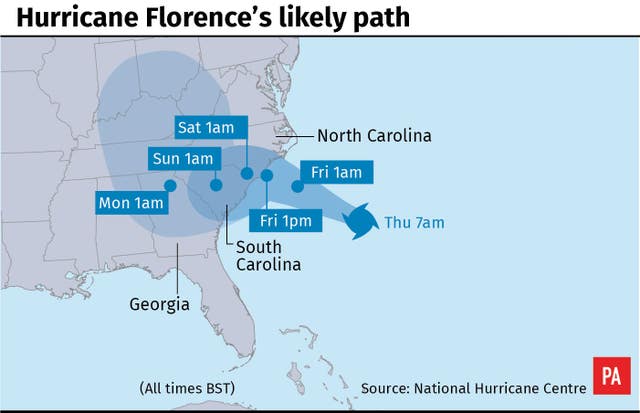
Outer bands of wind and rain from Hurricane Florence have begun lashing North Carolina as the monster storm moves nearer to the coast.
Florence’s top sustained wind speeds dropped from a high of 140mph to 110mph which reduced the hurricane’s power from Category 4 to Category 2.
However, forecasters warned the widening storm, and its likelihood of lingering along the coast for several days, raises the risk of surging ocean water and torrential rain.
“For a meandering storm, the biggest concern — as we saw with Harvey — is the huge amount of rainfall,” said Chris Landsea, head of tropical analysis and forecast branch at the National Hurricane Centre.
As of 8am local time, it was centred about 170 miles east-southeast of Wilmington, North Carolina and about 220 miles east-southeast of Myrtle Beach, South Carolina, moving north west at 12mph.
Hurricane-force winds were blowing 80 miles from its centre, and tropical storm force winds reached up to 195 miles from the eye.
The hurricane centre’s best guess was that Florence’s eye would blow ashore as early as Friday afternoon around the North Carolina-South Carolina border.
Then, it will probably hover along the coast on Saturday, pushing up to 13ft of storm surge and dumping 20 to 30 inches of rain on both states, before heading over the Appalachian Mountains.
Maximum winds from #Florence have decreased, but don’t let that fool you. This “weakening” only refers to maximum winds. The wind field has expanded and rainfall/storm surge potential are still at catastrophic levels.https://t.co/meemB5uHAR pic.twitter.com/IRiuxeVeUf
— NWS (@NWS) September 13, 2018
The result could be catastrophic inland flooding that could swamp homes, businesses, fields and industrial sites.
About 5.25 million people live in areas under hurricane warnings or watches, and 4.9 million more live in places covered by tropical storm warnings or watches, the National Weather Service said.
Weather Underground meteorology director Jeff Masters said Florence eventually could strike as a Category 1 with winds less than 100mph but that is still enough to cause at least $1 billion in damage.

Water kills more people in hurricanes than wind, and the rain and storm surge will make Florence extremely dangerous.
President Donald Trump both touted the government’s readiness and urged people to get out of the way.
“Don’t play games with it. It’s a big one,” he said at the White House.
#HurricaneFlorence https://t.co/mP7icn0Yzl pic.twitter.com/jOdKT02rbH
— Donald J. Trump (@realDonaldTrump) September 12, 2018
It is unclear exactly how many people fled, but more than 1.7 million people in the Carolinas and Virginia were urged to evacuate.
Airlines cancelled nearly 1,000 flights with more cancellations to come.
Here are the 11 PM EDT Key Messages for Hurricane #Florence. Latest information available at https://t.co/tW4KeFW0gB pic.twitter.com/Qckto38JyW
— National Hurricane Center (@NHC_Atlantic) September 13, 2018
Home Depot and Lowe’s activated emergency response centres to get generators, rubbish bags and bottled water to stores before and after the storm.
The two hardware chains said they sent a total of around 1,100 trucks.
Power company Duke Energy said Florence could knock out electricity to three-quarters of its four million customers in the Carolinas, and outages could last for weeks.
Workers are being brought in from the Midwest and Florida to help in the storm’s aftermath, it said.

Boarding up his home in Myrtle Beach, South Carolina, Chris Pennington watched the forecasts and tried to decide when to leave.
“In 12 or 18 hours, they may be saying different things all over again,” he said.
Computer models of exactly what the storm might do varied, adding to the uncertainty.
Based on the latest 11 a.m. forecast for the southward track of Hurricane Florence after making landfall and acting on a recommendation from @GeorgiaEMA officials, I have issued an emergency declaration for all 159 counties in Georgia. Read more here: https://t.co/FmO4iELdYq
— Governor Nathan Deal (@GovernorDeal) September 12, 2018
Reacting to the possibility of a more southerly track, Georgia governor Nathan Deal declared an emergency but did not immediately order any evacuations.
“I ask all Georgians to join me in praying for the safety of our people and all those in the path of Hurricane Florence,” Mr Deal said.
The shift in the projected track spread concern to areas that once thought they were relatively safe.
In South Carolina, close to the Georgia line, Beaufort County emergency chief Neil Baxley told residents they need to prepare again for the worst just in case.
“We’ve had our lessons. Now it might be time for the exam,” he said.
In Virginia, where about 245,000 residents were ordered to evacuate low-lying areas, officials urged people to remain away from home despite forecast changes showing Florence’s path largely missing the state.

Forecasters worried the storm’s damage will be all the worse if it lingers on the coast.
The trend is “exceptionally bad news,” said University of Miami hurricane researcher Brian McNoldy, since it “smears a landfall out over hundreds of miles of coastline, most notably the storm surge”.
With South Carolina’s beach towns more in the bull’s-eye because of the shifting forecast, Ohio tourists Chris and Nicole Roland put off their departure from North Myrtle Beach to get the maximum amount of time on the sand.
Most other beachgoers were long gone.
“It’s been really nice,” Nicole Roland said. “Also, a little creepy. You feel like you should have already left.”


Comments: Our rules
We want our comments to be a lively and valuable part of our community - a place where readers can debate and engage with the most important local issues. The ability to comment on our stories is a privilege, not a right, however, and that privilege may be withdrawn if it is abused or misused.
Please report any comments that break our rules.
Read the rules here